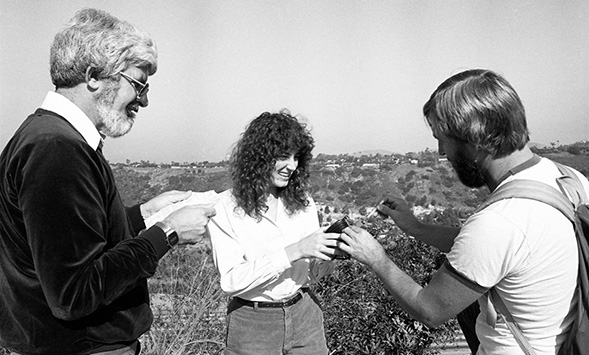The History of SDSU Research: 1970-2000
SDSUs research success between 1970-2000 set the groundwork for a rapid upward trajectory at the beginning of the 21st century.

This is the second installment in a series (Part 1) detailing SDSU’s history in the field of research.
From 1970 through 2000, San Diego State University’s research portfolio continued to grow. The university added joint doctoral programs in clinical psychology, education, biology, ecology, public health, electrical and computer engineering, mechanical and aerospace engineering, audiology and more. SDSU’s research success at this time set the groundwork for a rapid upward trajectory at the beginning of the 21st century.
1970 – Nation’s first Women’s Studies program established
In 1970, SDSU formally established the first Women's Studies program in the United States. The program offered 11 courses in its first year. Five years later, the university officially established Women's Studies as a department in the College of Arts and Letters. Today the department remains a leader in the field.
1974 – Officially becoming a university
Established as the San Diego Normal School in 1897, the institution transitioned to San Diego State Teachers College, then San Diego State College. In 1972, the school was renamed California State University, San Diego, and then, finally in 1974, San Diego State University.
1981 – Graduate School of Public Health opens
Recently shortened to the School of Public Health, programs in this school are among SDSU's most highly ranked. The school, founded as part of the university’s focus on health and human services in the 1980s, provides opportunities for education, research, and community involvement to advance the state of knowledge in different health disciplines and to improve the population’s health.
1983 – SDSU’s longest running grant begins
Biologist Sanford Bernstein joined the university and received a grant from the National Institutes of Health to study muscle degeneration in fruit flies. This research is now used to study several human muscle and cardiac diseases in an effort to understand their causes and potential treatments. Thirty-five years later, Bernstein is still receiving NIH support for his project. His grant is one of the longest-running in NIH history and remains the longest-running among SDSU researchers.
1983 – Border and local issues prioritized
In the 1980s, the university already had a robust, federally funded Center for Latin American Studies, but it strengthened resources focusing on the border and U.S.-Mexico issues. SDSU established the Institute for Border Studies and the Institute for Regional Studies of the Californias, which included an active research center that is still going strong today.
1984 – Faculty research recognized
The Albert W. Johnson University Research Lectureship was established to honor faculty with highly influential achievement in their research and scholarship. The award remains one of the highest university honors an SDSU faculty member can receive. The recipient of this lectureship delivers a public lecture during the spring semester and is named a Distinguished Professor in his/her discipline.
1992 – Grant funding continues to climb
By this time, the SDSU Research Foundation was administering $87.3 million in research grant revenue—more than triple its volume a decade earlier.
1993 – SDSU graduate goes to space
SDSU alumna Ellen Ochoa (’80) became the first Hispanic woman to travel to space aboard the shuttle Discovery, where she helped conduct a variety of on-board experiments. Ochoa was recently elected vice chair of the National Science Board, the governing body of the National Science Foundation, for the 2018-2020 term.
For a complete view of the university's research history, visit our interactive timeline.



